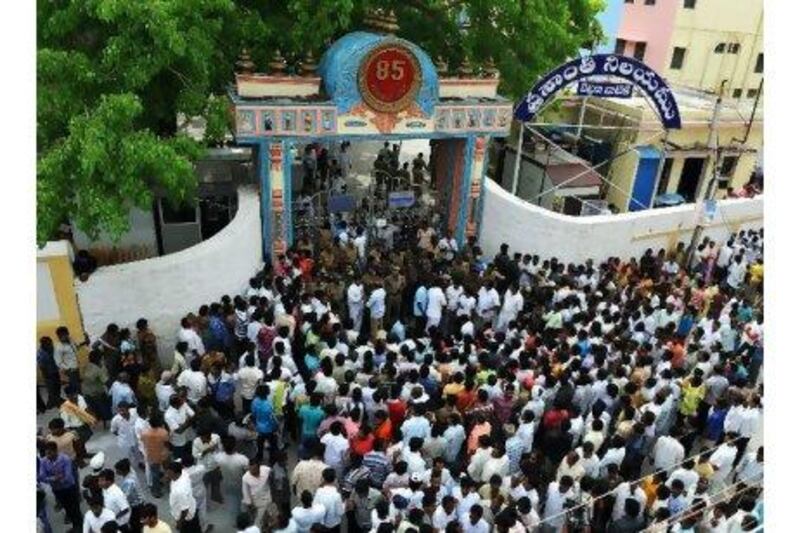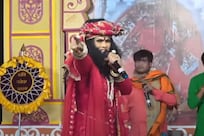NEW DELHI // The Indian spiritual leader Sathyanarayana Raju, known to many millions of devotees by the honorific Sathya Sai Baba, died yesterday at the age of 84.
The Sai Baba had been ill for more than a month, and had been admitted to the Sathya Sai Institute of Higher Medical Sciences in his hometown of Puttaparthi in the state of Andhra Pradesh.
In a statement, Dr AN Safaya, the director of the hospital, said the Sai Baba "left his earthly body on April 24, 2011 at 7:40am due to cardio-respiratory failure".
The Indian prime minister, Manmohan Singh, paid homage to the Sai Baba, born on November 23, 1926, by describing him as a "spiritual leader and an iconic figure who inspired millions". LK Advani, a leader of the Bharatiya Janata Party, who had met the Sai Baba, said India had been "plunged into darkness" by his death.
In his biography Sathya Sai Baba: A Life, the author Bill Aiken claimed the Sai Baba had 30 million followers around the world. Other media estimates put the number of devotees closer to five million.
Dr Safaya appealed to pilgrims to remain calm and pay their respects "in an orderly manner". The Sai Baba's body will lie in state before a funeral on Wednesday.
His condition had deteriorated over the past two weeks, even as hundreds of pilgrims arrived in Puttaparthi. On Saturday morning, doctors pronounced his chances of recovery slim, and indicated that he was being kept alive by a respirator and a dialysis machine.
Just before his death was announced, crowd control in Puttaparthi was stepped up, anticipating the arrival of mass crowds of pilgrims, as well as celebrities and political leaders.
The title Sai Baba is not a common one. It was first adopted by a religious leader from the town of Shirdi, in Maharashtra state, in the 19th century. In 1940, according to the official biography, a 14-year-old Sathyanarayana Raju announced to his family that he was a reincarnation of the earlier Sai Baba.
Around that time, having dubbed himself Sathya Sai Baba, he began travelling around south India, attracting crowds by performing "miracles": pulling trinkets out of thin air, for instance, or seemingly producing streams of "vibhuti" - a sacred ash - out of his hand that followers applied to their foreheads.
The Sai Baba preached the tenets of no particular religion, but the majority of his devotees were Hindus, and his lectures often drew on Hindu scripture.
Along with the "miracles" of his youth, the Sai Baba was claimed to have cured followers of ailments. In an 11,000-strong e-mail forum, for instance, a devotee named Kumar Mahadevan wrote that the Sai Baba had sent a sachet of sacred ash to his father, who suffered from throat cancer. The ash, Mr Mahadevan wrote, was applied to his father's stomach. "When the doctors came to check up at 9pm, the cancerous growth had shrunk to such an extent that it was almost invisible," Mr Mahadevan's e-mail said. "My father lived for another 23 years, until a ripe old age of 89."
As his renown spread, his empire expanded. There are now more than a thousand Sathya Sai Baba Centres in 114 countries. The Sathya Sai Baba Central Trust is said to control nearly $9 billion (Dh33bn) in funds, according to media reports. The trust has helped set up hospitals across India.
In his book Redemptive Encounters, the anthropologist Lawrence Babb called the Sai Baba a "jet-age holy man", one who had risen to be "the premier deity of India's English-speaking and generally high-caste middle classes".
The Sai Baba counted among his followers the star cricketer Sachin Tendulkar, the scientist and former president APJ Abdul Kalam, and the Malayalam film actor Mohanlal.
"The number of service activities he's undertaken, no government organization has done in India," said Veejay Sai, a Bangalore-based writer. "I've seen my share of fraudulent godmen, but this was a man of integrity. I can give you the name of 50 people who have had major surgeries at his hospitals without spending a single rupee." Yet the Sai Baba also had a legion of detractors who accused him of fraud, sexual abuse, money laundering, and powerbroking.
In 2004, a BBC documentary entitled The Secret Swami featured devotees telling an interviewer about being sexually fondled and abused by the Sai Baba. Wrist watches that he "materialised" and handed to his followers, claiming they were made of gold, turned out to be fake.
Rationalists demonstrated how he performed his "miracles" by secreting pellets of ash between his fingers, or in the sleeves of his robes.
The documentary also referred to a grisly incident that occurred in Puttaparthi and that has never been fully explained. In 1993, four devotees had broken into the Sai Baba's quarters, armed with knives. The Sai Baba escaped, and policemen who arrived opened fire, killing all four. A police official claimed that the firing had been in self defence, but a former Andhra Pradesh minister has alleged the encounter to be "absolute cold-blooded murder".
As he never married and has no children, the Sai Baba's death is expected to set off a tussle over control of the Sathya Sai Baba Central Trust. The two prime candidates to head the trust are RJ Ratnakar, the Sai Baba's nephew, and Satyajit, who uses only one name and who has been the Sai Baba's personal carer for many years.
[ ssubramanian@thenational.ae ]






